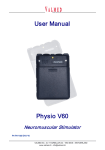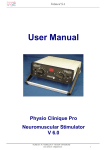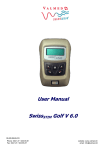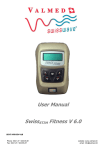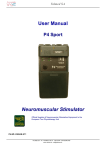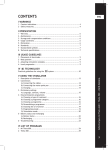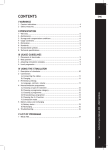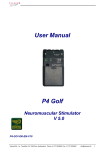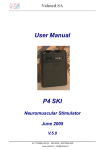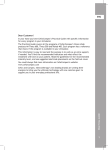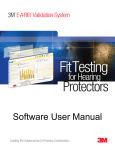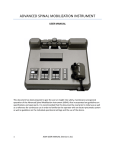Download to the SwissSTIM® PHYSIO user manual.
Transcript
User Manual SwissSTIM Physio V 7.0 2005 Phone: ..41 27 / 203.65.81 Fax: ..41 27 / 203.65.87 Version 1.1 1 website: www.valmed.ch email: © Valmed SA,[email protected] Switzerland I. Introduction The SwissSTIM TM Physio is manufactured/distributed by VALMED SA, Sion, Switzerland. The SwissSTIM Physio is manufactured in accordance with the requirements of European Safety Standards EN 60601-1, EN 60601-2-10 and meets all requirements of the American Safety Standards for Transcutaneous Stimulators as set forth in ANSI/AAMI NS4 – 1985. It is approved by the United States Food and Drug Administration (FDA) (K022175). The SwissSTIM Physio is a Class II Medical Device and conforms to the requirements of European Directive CEE 93/42 and holds certificate number Œ 0476. BF device IAW IEC 601-1 “External Placement on Body”. ! Physio . Read this User Manual, especially SECTIONS 3 and 4 before using the SwissSTIM Manufacturer is not liable for any damage caused by the improper use of the SwissSTIM Physio stimulator. 2 neuromuscular © Valmed SA, Switzerland II. Table of Contents I. Introduction 2 II. Table of Contents 3 III. Indications, Contraindications, Warnings, Precautions and Guidelines 4 IV. Terminology, Safety, Treatment and Electrode Data 6 V. SwissSTIM Physio Unit Components 9 VI. Operating Instructions 10 VII. Program Descriptions 15 VIII. Useful Information 20 IX. SwissSTIM Physio Technical and Safety Data 21 X. Electrode Placements and Program Guide 23 XI. Program Reference Guide 26 3 © Valmed SA, Switzerland III. Indications, Contra-Indications, Warnings, Precautions and Guidelines A. Indications The SwissSTIM Physio is intended for use by licensed health practitioners, patients under the care of licensed health professionals and is limited to prescription sales. The SwissSTIM Physio treatment programs are designed and intended for stimulation of all parts of the body EXCEPT transthoracically, the head and the front part of the neck. The specific indications for use include: • • • • • • B. Prevention or retardation of muscle disuse atrophy Relaxation of muscle spasms Increasing local blood circulation Muscle re-education and strengthening Immediate post-surgical stimulation of calf muscles to prevent venous thrombosis Maintaining or improving range of motion of extremities Medical Contraindications Do NOT use the SwissSTIM Physio on patients who have: • • C. An implanted cardiac pacemaker, defibrillator or other implanted electronic or metallic devices Any type of cancer in active metastatic phase. Warnings for Medical Professionals • • • • • • • • • • • • Do not use in the presence of functioning high frequency electrosurgery devices Do not use in the immediate vicinity (< 0.5 meter/2 feet) of active microwave ovens Long-term effects of chronic electrical stimulation are not known. Keep out of the reach of children Apply electrodes ONLY to normal, intact, clean skin. Do not apply electrodes over open wounds or over swollen, infected or inflamed areas or skin eruptions, e.g., phlebitis, thrombophlebitis, varicose veins, etc. DO NOT APPLY STIMULATION: o Over frontal area of the neck (near carotid sinus nerves). o Over the neck or mouth. Severe spasms of the laryngeal and pharyngeal muscles may occur with contractions strong enough to close the airway and/or cause difficulty in breathing. Stimulation over the neck could also have a adverse effects on the heart rhythm or blood pressure. o Transcerebrally or transthoracically o Over, or in proximity to, cancerous lesions. o On patients who have a hernia (abdominal or inguinal) o To the frontal, laryngeal and temporal regions of the neck. Advise patients to never use the SwissSTIM Physio while driving, operating machinery or during activities in which involuntary muscle contractions may endanger the user or others. The effects of stimulation of the brain are unknown. Therefore, do not apply stimulation across the head and do not place electrodes on opposite sides of the head. Do not allow use of the SwissSTIM Physio in the bath or shower. Patients with suspected heart problems or epilepsy must obtain appropriate medical advice. Never allow use of the SwissSTIM Physio while sleeping. NEVER immerse the SwissSTIM Physio unit in any liquid. 4 © Valmed SA, Switzerland D. Health Precautions • The safety of neuromuscular stimulation during pregnancy has not been established. • Use caution when/if: o Patient has skin areas that lack normal sensation. o Following surgical procedures if muscle contractions might impede the healing process. o Over a menstruating or pregnant uterus. o There is a tendency to bleed internally following acute trauma or fracture • Place electrodes in accordance with illustrations in this User Manual. • Ensure that patient extremities are isometrically fixed (braced) during treatment sessions to prevent movement that results from stimulation. • This unit should not be used while driving, operating machinery or during any activity in which involuntary muscle contractions may place the user at undue risk of injury. • Some users may experience skin irritation or hypersensitivity due to the electrical stimulation or the conductive medium. • Application of moderate heat (thermal wrap) to muscles as well as moistening skin prior to treatment improves treatment efficacy; use of cold packs on treated muscles after treatment is likewise recommended. • This unit should only be used with the leads, electrodes and accessories provided by the manufacturer. E. DO NOT use the SwissSTIM Physio on patients who • • • • • F. Have an implanted cardiac pacemaker, defibrillator or other implanted electronic or metallic devices Are pregnant Have cardiac problems or cardiac disease Have epilepsy Have abdominal or inguinal hernia Electrode Guidelines The PalsFlex electrodes that are supplied as a standard accessory with the SwissSTIM Physio mold easily to body contours and are reusable. The specific instructions for electrode use are indicated on the factory sealed storage pouch. The recommended sizes are oval 3” by 5” electrodes for large areas (e.g., leg muscles) and round 3” electrodes for smaller areas such as forearm muscles. • Use only skin pads (electrodes) supplied by manufacturer. Other electrodes may not stimulate correctly and may render the treatment ineffective. • Apply electrodes only to clean, intact, normal skin. • Do not apply electrodes over open wounds, inflamed, swollen or infected skin area or over any skin eruptions such as varicose veins, phlebitis, etc. • Do not share electrodes with other patients. Multiple patient use may result in adverse skin reactions. • Replace self-adhesive electrodes when they do not adhere (stick) firmly to the skin G. Potential Adverse Reactions Skin irritation and burns beneath the electrodes has been reported from use of some neuromuscular stimulators. 5 © Valmed SA, Switzerland IV. Terminology, Safety, Treatment and Electrode Data A. Terminology Human physical movements are determined by muscle actions on the skeletal system. A muscle is shortened (contracts) when it is “voluntarily” activated by the brain. This shortened muscle exerts force on the attached bone(s), causing movement with skeletal joints acting as pivots. All muscle contractions are controlled by the brain through very efficient electrical stimulation signals that travel through motor nerves. A signal will activate a discrete number of muscle cells known as a “motor unit”; a motor unit is a single motor nerve and the muscle cells connected to it. Groups of motor nerves and muscle cells are known as “motor points”. The full contraction of a muscle typically involves multiple motor units acting simultaneously; the force of contraction is proportional to the number of motor units activated. The gradual activation of motor units enables smooth and controlled development of force; this process is known as “spatial summation”. Neuromuscular stimulation using the SwissSTIM Physio achieves similar muscle movement without use of brain signals. These movements are termed “involuntary”. When a single electrical impulse of adequate intensity is applied externally (involuntarily) to a group of neuromuscular junctions (motor points) in a muscle, the result is a single short contraction (twitch) in that muscle. When these single twitches are repetitive and the repetition rate exceeds 10 twitches per second, the contractile force of each succeeding twitch adds to the preceding twitch an additional degree of contraction, resulting in a higher overall force and, hence, muscle contraction. This “effect” is termed “temporal summation”. The minimal repetition rate at which twitch contractions “fuse” together is termed the “tetanization frequency”, typically in the range of 25 to 50 impulses per second, depending upon the specific muscle. Tetanization frequencies are used to create electrically stimulated contractions known as tetanic muscle contractions. During natural (voluntary) muscle contractions, the force is partly the result of summation of single repetitive twitches (temporal summation) but also a function of the total number of motor units that have been activated by brain signals. Therefore, a voluntary muscle contraction force is a result of both temporal and spatial summations. During neuromuscular electrical stimulation, the muscle contraction force is highest at the tetanic stimulation frequency due to temporal summation. Contraction force also depends upon the total number of motor units activated, which, in turn, are dependent on placement of electrodes and their distance to the motor points on a muscle. B. Safety The SwissSTIM Physio is designed to provide a totally safe treatment without sacrificing effectiveness. In this respect, the SwissSTIM Physio is non-pareil. Further, to ensure safety, durability and efficiency, only premium electrical components are used. All stimulation impulses generated during SwissSTIM Physio treatment sessions carry such minimal amounts of electrical energy that they are unlikely to produce any adverse effects when 6 © Valmed SA, Switzerland the stimulator is used in accordance with this manual. It is important, however, to emphasize that no neuromuscular stimulator, including the SwissSTIM Physio should be used by a patients with an implanted cardiac pacemaker and that the safety standards for pregnant women has not been established. The SwissSTIM Physio is designed so that even improper or accidental application of the stimulator will not produce cardiac rhythm disturbances (this does not apply to persons who have implanted cardiac pacemakers). This safety factor is due to the minimal electrical charge of the stimulating impulses, which, under all conditions, do not exceed 24 microcoulombs, zero net current. This charge is below the standard of 25 microcoulombs established in the Association for Advancement of Medical Instrumentation (AAMI) for cardiac rhythm disturbance safety (AAMI/ ANSI NS-4-1985). Many, if not most, individuals harbor apprehension, anxiety or even fear regarding electricity. It is therefore very important that patients understand how completely safe treatments with the SwissSTIM Physio are. Educating the patient before treatment is therefore a recommended first step! The effective value of the stimulation voltage a patient will experience during treatment with the SwissSTIM Physio is very low, below 5 volts (root mean square) at the maximum setting of the intensity knobs. C. Practical Treatment Suggestions During neuromuscular stimulation, the number of motor units in a muscle that are activated depends upon the stimulus impulse energy. This imparted impulse energy, in turn, is a function of: • • • The current intensity selected by the practitioner for the patient; Skin and electrode electrical resistance; less resistance results in more delivered energy, and; Electrode placement; the closer electrodes are to motor points, the higher the energy. The intensity of the stimulation should be at a level where the involuntary muscle contractions are visible and felt by the person to be treated. The controls on the SwissSTIM Physio are easily adjusted to achieve this. It is likewise true that the stronger the muscle contractions are, the higher the effectiveness of the therapy. This has to be tempered, however, with a person’s comfort level. For comfortable and effective stimulation, the delivered energy should be optimized. This can be achieved by a combination of the following steps: • • • • • • Ensure that the person’s skin is clean; Apply heat (for example, a thermal wrap) to the skin to increase local blood circulation; Moisten skin before placing the electrodes on the skin; Reduce electrode resistance by using the largest electrodes possible for a given anatomical area; Optimize electrode placement using the placements recommended in this manual, and; If possible, have the person to be treated assist by also voluntarily contracting the stimulated muscles. Dry skin is highly resistant to the conduction of electric current. Wet (or perspiring) skin has significantly lower resistance. It is true that individuals tend to vary in their normal levels of skin 7 © Valmed SA, Switzerland moisture. It is also best to precede treatments with the application of some form of heat to the areas to be treated. There are a number of means for doing this, form thermal wraps to steam baths or hot whirlpool treatments. Oily skin also prevents optimal conductivity and should be treated with soap and water prior to start of a treatment session. As a minimum, the skin should be moistened with a sponge or cloth prior to treatment. D. Application and Handling of Electrodes When voluntary muscle movements occur, the complex contraction patterns involving several muscles, bones and joints are represented in the cerebral cortex of the brain rather than the movement of each individual muscle. Thus, the brain typically calls a combination of muscles into action; this should be the objective when using neuromuscular stimulation (NMS) as well. There are several different methods for placing electrodes on the body. The following guidelines are based on using NMS to exercise groups of muscles involuntarily in the same fashion that these muscles contract voluntarily. Electrode in pairs layout is the recommended electrode placement. Each pair of electrodes is placed on the same side of the body (e.g., one electrode on the right leg vastus lateralis and the other on the same leg on the vastus medialis), both being a part of the quadriceps muscle group. Split electrode layout is when one pair of electrodes is split on each side of the body (e.g., one electrode on the right quadriceps and one electrode on the left quadriceps). This layout may result in unevenness of contractions which may be difficult to correct. Bi-polar electrode layout is ideal for large muscles. An electrode is placed at each end of the muscle such that good, well-controlled contractions are obtained. For all layouts, the electrode placement should correspond to the location of the motor points of the treated muscle(s). For placement guidance, see Section X. THE BOTTOM LINE? The SwissSTIM Physio is a truly valuable adjunct for the medical professional in assuring effective treatments for: • • • • • • Prevention or retardation of muscle disuse atrophy Relaxation of muscle spasms Increasing local blood circulation Muscle re-education and strengthening Immediate post-surgical stimulation of calf muscles to prevent venous thrombosis Maintaining or improving range of motion of extremities 8 © Valmed SA, Switzerland V. SwissSTIM Unit Components Connectors for Electrode Cables Display Menu Navigation keyboard Note: Battery compartment and SMART CARD access located in back of SwissSTIM Physio 9 © Valmed SA, Switzerland VI. Operating Instructions A. Key Symbols and Functions S Select Key Use this KEY to select a program, select a program “phase” and to START a selected program. Once a program has started, use this KEY to make further selections in the program. Multiple Function/Scroll Keys Use either key to turn the SwissSTIM Physio ON When the SwissSTIM Physio is ON, use these keys to scroll through the programs Once a stimulation program has started, use these keys to increase the stimulation Intensity (one key for each channel). Multiple Function/Scroll Keys When the SwissSTIM Physio is ON, use these keys to scroll through the programs Once a stimulation program has started, use these keys to decrease the stimulation Intensity (one key for each channel) After stimulation program is completed use either key to turn the SwissSTIM Physio OFF B. Display (LCD Screen) Indications SwissSTIM Physio START SCREEN Example Program Screen MENU NAVIGATION KEY SCROLL INDICATORS PROGRAM NUMBER INDICATOR PROGRAM NAME INDICATOR PROGRAM DURATION INDICATOR (minutes) PROGRAM PHASE NUMBER INDICATOR 10 © Valmed SA, Switzerland SELECTED PROGRAM PHASE DURATION INDICATORS (minutes) WARM-UP PHASE AND DURATION INDICATOR Indicate that warm-up phase is selected (dark background) and lasts eleven minutes SPECIFIC WORK PHASE INDICATOR AND DURATION Indicate the specific work phase and five minutes duration FINAL COOL-DOWN PHASE INDICATOR AND DURATION Indicate the winding-down phase and four minutes duration BATTERY CHARGE INDICATOR Example STIMULATION INTENSITY INDICATORS ON EACH CHANNEL Indicate stimulation Intensity level (independently set on the two channels) Example END OF PROGRAM INDICATOR The session is over, 4 beeps can be heard. Switch the unit OFF by pressing one of the two keys with a downward pointing arrow ( ) 11 © Valmed SA, Switzerland SMART CARD ABSENT INDICATOR The smart card on which the programs are recorded is not in place, or is not properly inserted. Switch unit OFF, open the back battery slot and insert the smart card or check that card is correctly positioned. SMART CARD INVALID INDICATOR The smart card inserted in the back slot is not valid. Switch unit OFF, open the back battery slot and insert a valid smart card. INFORMATION ON FUNCTIONS DURING TREATMENT PAUSE: Pause mode during treatment STOP: Enables user to stop the program before pre-set time RESUME: Enables user to quit PAUSE mode and resume treatment from where it was stopped. CHANGE PHASE OPTION: Enables the user to return to the phase menu and repeat or lengthen one particular phase or skip to the following phase. C. Inserting New Batteries Slide back cover until battery compartment is open. Insert new battery; use ONLY a 9 volt alkaline or lithium (high quality) battery and ensure proper polarity (+/-). D. Inserting or Replacing “Smart Card” The “Smart Card” contains the specific program information for your SwissSTIM Physio (your stimulator comes with this card installed). If the card needs to be installed, do so ONLY when your SwissSTIM Physio is OFF. Open battery compartment and insert the “Smart Card” into its slot, making sure that the card is properly positioned (LABEL on the card facing up). E. Turning the SwissSTIM Physio ON Press one of the scroll keys marked to turn the SwissSTIM Physio ON. This activates the LCD screen and sound but not the Intensity function. This function is only activated 12 © Valmed SA, Switzerland after a program selection has been made. If the SwissSTIM Physio logo does not appear or if the display indicates low battery strength, the SwissSTIM Physio will not function properly. If the message “SWITCH OFF NOW AND INSERT CARD” appears, turn the SwissSTIM Physio OFF by pressing one of the scroll keys. Insert “Smart Card”. If the message “INVALID CARD CHANGE CARD” appears, an invalid card has been inserted. F. Selecting a Stimulation Program and Duration Make sure the SwissSTIM Physio is ON. The LCD display will indicate the number of programs. Scan the programs by using the scroll keys and select desired program and duration. Once a program is selected by using the S Select KEY, the LCD display will show specific information about the program (name, total program duration and program phases/phase length). The program will start with the first program phase (unless a specific phase is selected) and will complete ALL phases of the program unless the user selects only a specific program phase. G. Selecting a “Phase” of a Stimulation Program Selecting only a program phase is possible. Once a program has been selected, icons for the program phases will appear on the LCD display. Use the scroll keys to highlight the desired phase and press the S Select KEY to select the phase. H. Automatic Program OFF Function If no scroll key is pressed within 60 seconds, the SwissSTIM Physio will automatically switch OFF to conserve battery life. I. Selecting Program Intensity Once a program has been selected, the Intensity controls on the SwissSTIM Physio are activated. There are 2 scroll keys (a and a ) for each (right and left) channel of the scroll key for each channel to increase Intensity and the SwissSTIM Physio. Use the scroll key to decrease the Intensity level. The Intensity scale is a 100 step scale, with 100 % corresponding to the maximum Intensity level. J. Using “Pause” Function Any SwissSTIM Physio program can be paused by pressing the S Select KEY once. When this is done, the following choices can be made: STOP – Stops program RESUME – Program resumes from point it was stopped CHANGE PHASE – Returns user to program phase menu and allows user to repeat a phase, skip to next phase or repeat the entire program 13 © Valmed SA, Switzerland K. Switching the SwissSTIM Physio OFF During Treatment. Press both scroll keys until the Intensity level falls to 0%; press one of the scroll keys again and the unit will beep and switch OFF. L. Connections Please refer, as needed, to the control schematic of the SwissSTIM Physio (page 9) 1. Ensure that the unit is OFF. 2. Connect the skin pads (electrodes) to each output cable. 3. Position the skin pads (electrodes) on the motor points of the muscles to be treated (refer to page 23 in this manual for proper positions). 4. Connect the output cables to the output socket of the SwissSTIM Physio unit. The two (2) cables can be connected to either output socket on the SwissSTIM Physio; the SwissSTIM Physio unit will function properly M. Automatic Switch-OFF The SwissSTIM Physio will automatically switch OFF three (3) minutes after completion of a program. To turn the unit OFF immediately, press one of the scroll keys. N. Troubleshooting If the SwissSTIM Physio unit is not working, please check the following: 1. 2. 3. 4. Is the battery correctly inserted? Are the cable connectors properly inserted into the SwissSTIM Physio unit? Are the skin pads (electrodes) connected to the cables? Are the skin pads (electrodes) adhering to the skin? If not, wet the pad surfaces sparingly with water. With incorrect, non-symmetrical, stimulation feeling please check the following: 1. 2. 3. 4. 5. Electrodes may be dry or greasy Electrodes not positioned correctly Weak battery Non-symmetrical positioning of the electrodes (See Section X.) Intensity on the two channels are set differently 14 © Valmed SA, Switzerland VII. PROGRAM DESCRIPTIONS The SwissSTIM Physio has four basic muscle stimulation programs; each program is offered in three treatment times for a total of 12 discrete program options. The four basic programs address specific stimulation application for skeletal muscles (see Guide on page 26). Always stimulate muscles isometrically; make sure that the limb whose muscle(s) is being stimulated is firmly secured to prevent the movement of the limb (resulting from muscle contraction). Medical professionals should select the appropriate treatment time: 20, 30 or 40 minutes. If longer treatment times are desired, for example if home treatments are prescribed for a patient, the prescribed programs may be repeated by the user or multiple programs used. Using complete program stimulation cycle (3 phases) is recommended. SwissSTIM Physio treatment modalities are: A. RELAXATION OF MUSCLE SPASM If a muscle spasm is present in any part of the body, the spasm can be relieved by immediate application of stimulation to the affected muscle(s). A spasm, which is usually painful, is inhibited after stimulation and the relief will last for some time. It is normal to experience a return of pain. It may even be reported as an aggravation of pain by some patients. This is only relative and temporary, and the spasm free periods following treatment will become longer and longer until the pain disappears. To relax the spasms, place at least two electrodes on each muscle in such way that the direction of stimulation (a straight imaginary line between the electrodes) is aligned with the longitudinal axis of the muscle. Program(s) Program 1 is best suited; however, Program 4 can be used, if preferred by the patient. Treatment frequency No more than every 2 hours, for as long as needed Stimulation intensity During the first 2 treatments at light intensity, well below maximum. Thereafter, increase the intensity for subsequent treatments in accordance with patient tolerance. B. PREVENTION OR RETARDATION OF MUSCLE ATROPHY When immobilized for medical reasons, all muscles are subject to atrophy (wasting). To remedy this, stimulation of muscles is recommended when normal physical exercise is impossible. Program(s) Program 2 only for at least first 5 treatments; follow with Program 2 in combination with Program 3 for more intense workout. Treatment frequency Every 24 hours but not less than every 48 hours, for as long as immobilization lasts. 15 © Valmed SA, Switzerland Stimulation intensity Initially low, progressively increasing to reach the maximum patient tolerance level. C. PARTIAL ATROPHY AND/OR SPASM OF PARASPINAL MUSCLES The SwissSTIM Physio is especially effective for relieving spasm and accompanying discomfort in the spinal region. The stimulating electrodes should be placed symmetrically on both sides of the spine (see electrode placement photos) at the level of maximum discomfort or in positions indicated by the prescribing physician. The following treatment procedure is recommended: Program(s) Program 1 only for the first 5 treatments at maximum tolerable intensity in order to relieve muscle spasm, followed by Program 2 for subsequent treatments. Treatment frequency every 24 hours, for 7 to 10 days Stimulation intensity initially low, progressively increasing to reach the maximum patient tolerance level Normally, spasms, which are usually painful, are inhibited right away following the treatment and the relief lasts for some time. It is normal to experience return of pain after some time following each treatment. It may even be reported as an aggravation of pain by some patients. This is only relative and temporary, and the spasm free periods following treatment will become longer and longer until the discomfort disappears. Stimulation in such cases has not only spasm relieving action but also it may reeducate paravertebral muscles to provide better support for the spine, thus preventing the recurrence of back problems. D. INCREASING LOCAL BLOOD CIRCULATION Local blood flow increases with stimulation and reaches a peak within the first 15-20 minutes from the onset of stimulation. Therefore, short stimulation treatments are recommended. Program Program 1 is recommended, although blood flow increase happens as a beneficial side effect when using any stimulation program. Treatment frequency every 24 hours, or as needed Stimulation intensity initially low, progressively increasing to reach the maximum patient tolerance level. E. MUSCLE RE-EDUCATION Muscle stimulation may be applied to patients before, during or after physiotherapy re-education. Stimulation may also be applied during and/or after immobilization following orthopedic surgery involving the long bones and joints. After deciding which parts of the body are to be treated, and, upon selection of the appropriate number of electrodes and their location, use the following simplified application method: 16 © Valmed SA, Switzerland Program(s) If muscle spasm is present, start with Program 1 followed by Program 2. Otherwise, use only Program 2. Treatment frequency Daily or on alternate days Number of treatments : Normally 20 treatments, but can be increased to 40 when necessary to reach the treatment goals or recovery of normal or desired functions. Stimulation intensity Initially low, progressively increased after two or three treatments, reaching maximum setting, when possible, by the eighth treatment session. For most effective reeducation of muscles and joints, the following factors are important: • Try at all times to use the optimal stimulation intensity, i.e., the strongest contractions should be achieved within the limits of patient comfort and tolerance with no pain. • Stimulation intensity has no absolute value and may vary from day to day and also during a treatment. Thus, when the skin and muscles are warmed (using thermal wraps, for example), or a series of massages (or a steam bath) have been performed before a stimulation treatment, a slightly lower intensity will suffice to give the desired effect. • It is possible to treat several areas at once on one patient, allowing considerable saving of time. • It is possible to mount the stimulator electrodes on the skin under a cast and thus prevent muscle atrophy even on a limb which is fully immobilized, as for instance in patients in a pelvipaedic cast. F. CALF MUSCLE STIMULATION FOR THE PREVENTION OF VENOUS THROMBOSIS BY IMMEDIATE POSTSURGICAL STIMULATION Muscle stimulation is effective in reducing the evidence of, and preventing, the symptoms of venous thrombosis. After electrode placement on motor points of calf muscles, the following treatment method is recommended: Program Program 2 Treatment frequency As prescribed by physician or up to 3 x per day, for as long as the patient is immobilized Stimulation intensity Initially low, progressively increasing up to the maximum patient tolerance level. 17 © Valmed SA, Switzerland G. MAINTAINING OR INCREASING RANGE OF MOTION OF EXTREMITIES Electrical muscle stimulation may be applied to patients as an adjunct to physiotherapy procedures. After deciding which extremities are to be treated and upon selection of the appropriate number of electrodes and their location, use the following simplified application method: Program(s) If muscle spasm is present, start with Program 1 and follow with Program 3. Otherwise, use only Program 3. Treatment frequency Once per day, daily or on alternate days Number of treatments: Normally 20 treatments but can be increased when necessary to reach the treatment goals or recovery of normal or desired function. Stimulation intensity Initially low, progressively increased after two or three treatments, reaching maximum setting, when possible, at the eighth treatment session. For most effective maintenance of range of motion of extremities, the following factors are important: • At all times try to use the optimal stimulation intensity; i.e., the strongest contractions within the limits of patient comfort and tolerance, with no pain. • Stimulation intensity has no absolute value and may vary from day to day and also during a treatment. Thus, when the skin and muscles are warmed (using thermal wraps, for example), or a series of massages (or a steam bath) have been performed before the stimulation treatment, a slightly lower intensity will suffice to give the desired effect. • It is possible to treat several areas at once on one patient, which permits considerable time savings. 18 © Valmed SA, Switzerland The timing sequences and frequencies for the SwissSTIM Physio programs are shown in this table: Program 1 Program 2 Program 3 Program 4 Ramp just prior to contraction sec 3 3 3 Tetanic Contraction-Stimulus ON sec 6 12 9 Ramp plus contraction sec 9 15 12 Ramp after contraction sec - - - Relaxation after contraction Stimulus OFF sec 21 39 48 Stimulus frequency, maximum with tetanic contractions Hz Max 120 87 62 89 Max Impulse duration µs 300 220 250 180 Total Cycle sec 30 54 60 Program time (selectable) min 20/30/40 20/30/40 20/30/40 20/30/40 19 © Valmed SA, Switzerland VIII. A. Useful Information Inserting or Replacing Batteries The battery charge indicator will indicate when the battery weakens and requires replacement. If the battery is not replaced, the SwissSTIM Physio will cease operating within one (1) hour. Remove (slide) the cover of the unit. Remove old battery and insert a fresh 9-volt lithium, alkaline or rechargeable NiMh battery. Ensure proper battery polarity; the SwissSTIM Physio will not operate if polarity is reversed. B. Warnings Concerning Battery Handling Always read and follow the specific instructions provided by battery manufacturers. Note the following: • • • • • • • C. Ensure that battery polarity is correct. Do not expose batteries to temperatures exceeding manufacturer’s specifications. Do not store and/or ship this unit with batteries inserted. Do not attempt to recharge alkaline or lithium batteries. Do not dispose of any battery in fire. Note that batteries may present burn or fire hazard if short-circuited. Improper battery handling may result in explosion, leakage or flames. Handling/Cleaning the SwissSTIM Physio Unit Use soft brush or soft cloth to clean unit case; do not use liquid cleansers. Use same procedure with electrical leads. The SwissSTIM Physio is designed to be maintenance free. D. Storage Conditions The SwissSTIM Physio may be stored for prolonged periods with no degradation. REMOVE the battery when the unit is not used on a regular basis. E. Battery Disposal Always dispose of batteries in accordance with battery manufacturer instructions. F. Warranty Free replacement, for two (2) years, except for accessories and shipping charges. Free replacement will be made if defect is in manufacture of unit; free replacement does not apply when damages are related to improper use or abuse of unit. 20 © Valmed SA, Switzerland IX. SwissSTIM Physio Technical and Safety Data A. Technical Characteristics Stimulation Channels Two, independent, isolated channels. Separate Intensity control levels for each channel. Adjustments 5 keys control all stimulation functions and Intensity levels. Display The graphical LCD 100 X 30 pixels (46x16 mm) signals all stimulation functions, stimulation intensity per channel, length of program, battery charge status etc. Output Current waveform (during training): Asymmetrical biphasic with fast rise and zero net current. Voltage waveform (open circuit): Low voltage, rectangular, compensated monophasic impulse. Peak open circuit voltage during each impulse: 45 Vp ±10%. Maximum Output at 500 Ω Load RMS voltage: ≤ 5 V (volts) ± 10%. Peak open circuit voltage during treatment: 90mA (milliamperes) ± 10%. Power Supply One 9 Volt lithium, alkaline or NiMh rechargeable battery. Battery charge lasts approximately 20 hours, according to stimulation intensity. The output and program timing parameters are stable (±2%) throughout the life of the battery. Standard Accessories Four skin pads (nonpolar, self-adhesive, reusable electrodes) One alkaline 9 Volt battery 2 cables Carrying case and User Manual. Size Unit size is approximately 12.5*8.1*2.6 cm. Weight is 200 grams or approximately 7 oz. Cleaning/Maintenance Use soft brush or soft cloth to clean unit case; do not use liquid cleansers. Use same procedure with electrical leads. The SwissSTIM Physio is designed to be maintenance free. 21 © Valmed SA, Switzerland B. Safety The SwissSTIM Physio meets the requirements of ANSI/AAMI NS4 1985 American Standard and the IEC-601-2-10 European Safety Standard. Specific Safety Features and Measures to Prevent Misuse The SwissSTIM Physio is inherently designed so that improper or accidental application of this unit cannot produce cardiac rhythm disturbances. This does not include individuals with implanted cardiac pacemakers! This inherent safety is due to the minimal electric charge of all stimulating impulses in the SwissSTIM Physio. In all programs of stimulation, the typical impulse is below 10 micro coulombs and the maximum possible impulse is 20 micro coulombs, zero net current. Moreover, this maximum charge of 20 micro coulombs is significantly below the cardiac rhythm disturbance safety margin of 25 micro coulombs per pulse, the standard as established by the Association for Advancement of Medical Instrumentation (AAMI) in AAMI/ANSI standard NS4-1985 and acknowledged by the U.S. Food and Drug Administration (FDA). Specific safety features in the SwissSTIM Physio include: 1. Impossible for users to modify the embedded programs; users can only modify the intensity of stimulation 2. All programs begin with minimal electrical Intensity; the user must increase the Intensity to the desired training level. 3. Maximum possible electrical impulse is 20 micro coulombs. 4. Cable design prevent the possibility of accidental connection to a power source, such as an AC power outlet. 5. Automatic control of stimulation current density precludes excessive current density at the electrode-skin interface and ensures skin safety. 22 © Valmed SA, Switzerland X. Electrode Placement Use oval 3” by 5” electrodes for large areas (e.g., leg muscles) and round 3” electrodes for smaller areas such as forearm muscles. Do not use smaller electrodes than recommended above. Leads for Channel 1 are depicted in RED and leads for Channel 2 in BLUE. Where only one set of electrodes is shown, Channel 1 is depicted but Channel 2 may be used instead. Channels may be reversed, if desired, from that indicated in the following photos. Channel 2 electrodes may be attached to other leg in order to treat both legs CALVES QUADRICEPS On both legs THIGHS Channel 2 electrodes may be attached to other thighs in order to treat both thighs On one leg TIBIA FEMORAL BICEPS 23 © Valmed SA, Switzerland TRICEPS FEMORAL BICEPS AND CALVES ABDOMINALS FOREARM UPPER TRAPEZIUS BICEPS OR DELTOID 24 © Valmed SA, Switzerland LOWER TRAPEZIUS LUMBAR VERTEBRAE OR NECK BACK 25 © Valmed SA, Switzerland 26 X MUSCLE RE-EDUCATION MAINTAINING OR INCREASING RANGE OF MOTION OF EXTREMITIES Only with spasm present, continue with P3 X Use only if spasm is present, then continue with P2 X CALF MUSCLE STIMULATION FOR THE PREVENTION OF VENOUS THROMBOSIS BY IMMEDIATE POSTSURGICAL STIMULATION X X X Use P1 for at least Use P2 after first 5 first 5 treatments treatments X X X Use in combination with P2 after 5 treatments X (P3) Program 3 Use P2 for first 5 treatments (P2) (P1) X Program 2 Program 1 INCREASING LOCAL BLOOD CIRCULATION PARTIAL ATROPHY AND/OR SPASM OF PARASPINAL MUSCLES PREVENTION OR RETARDATION OF MUSCLE ATROPHY RELAXATION OF MUSCLE SPASM Indication to be Treated If preferred by patient X (P4) Program XI. Program Reference Guide © Valmed SA, Switzerland


























